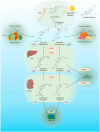Vitamin D and Cardiovascular Diseases: From Physiology to Pathophysiology and Outcomes
- PMID: 38672124
- PMCID: PMC11048686
- DOI: 10.3390/biomedicines12040768
Vitamin D and Cardiovascular Diseases: From Physiology to Pathophysiology and Outcomes
Abstract
Vitamin D is rightly recognized as an essential key factor in the regulation of calcium and phosphate homeostasis, affecting primary adequate bone mineralization. In the last decades, a more complex and wider role of vitamin D has been postulated and demonstrated. Cardiovascular diseases have been found to be strongly related to vitamin D levels, especially to its deficiency. Pre-clinical studies have suggested a direct role of vitamin D in the regulation of several pathophysiological pathways, such as endothelial dysfunction and platelet aggregation; moreover, observational data have confirmed the relationship with different conditions, including coronary artery disease, heart failure, and hypertension. Despite the significant evidence available so far, most clinical trials have failed to prove any positive impact of vitamin D supplements on cardiovascular outcomes. This discrepancy indicates the need for further information and knowledge about vitamin D metabolism and its effect on the cardiovascular system, in order to identify those patients who would benefit from vitamin D supplementation.
Keywords: cardiovascular disease; cholecalciferol; outcome; pathophysiology; vitamin D.
Conflict of interest statement
The authors declare no conflict of interest.
Figures



Similar articles
-
Vitamin D and Cardiovascular Disease, with Emphasis on Hypertension, Atherosclerosis, and Heart Failure.Int J Mol Sci. 2020 Sep 4;21(18):6483. doi: 10.3390/ijms21186483. Int J Mol Sci. 2020. PMID: 32899880 Free PMC article. Review.
-
Clinical utility of vitamin d testing: an evidence-based analysis.Ont Health Technol Assess Ser. 2010;10(2):1-93. Epub 2010 Feb 1. Ont Health Technol Assess Ser. 2010. PMID: 23074397 Free PMC article.
-
Potential pathophysiological role for the vitamin D deficiency in essential hypertension.World J Cardiol. 2014 May 26;6(5):260-76. doi: 10.4330/wjc.v6.i5.260. World J Cardiol. 2014. PMID: 24944756 Free PMC article. Review.
-
Vitamin D and Cardiovascular Disease: Current Evidence and Future Perspectives.Nutrients. 2021 Oct 14;13(10):3603. doi: 10.3390/nu13103603. Nutrients. 2021. PMID: 34684604 Free PMC article. Review.
-
Potential Beneficial Effects of Vitamin D in Coronary Artery Disease.Nutrients. 2019 Dec 30;12(1):99. doi: 10.3390/nu12010099. Nutrients. 2019. PMID: 31905893 Free PMC article. Review.
Cited by
-
Genetic Polymorphism of CYP2R1, CYP27A1, CYP27B1, and Vitamin D Metabolites Plasma Levels in Patients with Cardiovascular Disease: A Pilot Study.Biomolecules. 2025 May 11;15(5):699. doi: 10.3390/biom15050699. Biomolecules. 2025. PMID: 40427592 Free PMC article.
-
Comparison of cardiovascular autonomic function and biomarkers between vitamin D insufficient and deficient people with newly diagnosed type 2 diabetes mellitus.J Family Med Prim Care. 2025 Jun;14(6):2294-2300. doi: 10.4103/jfmpc.jfmpc_1804_24. Epub 2025 Jun 30. J Family Med Prim Care. 2025. PMID: 40726661 Free PMC article.
-
A Personalized Approach to Vitamin D Supplementation in Cardiovascular Health Beyond the Bone: An Expert Consensus by the Italian National Institute for Cardiovascular Research.Nutrients. 2024 Dec 30;17(1):115. doi: 10.3390/nu17010115. Nutrients. 2024. PMID: 39796548 Free PMC article. Review.
-
The Anti-Inflammatory Roles of Vitamin D for Improving Human Health.Curr Issues Mol Biol. 2024 Nov 26;46(12):13514-13525. doi: 10.3390/cimb46120807. Curr Issues Mol Biol. 2024. PMID: 39727935 Free PMC article. Review.
-
Vitamin D Status and Cardiovascular Risk Factors in Patients with Type 2 Diabetes Mellitus: A Cross-Sectional Study in a Tertiary-Level Hospital in Antananarivo, Madagascar.Diabetes Metab Syndr Obes. 2024 May 31;17:2191-2198. doi: 10.2147/DMSO.S467316. eCollection 2024. Diabetes Metab Syndr Obes. 2024. PMID: 38835729 Free PMC article.
References
-
- De Luca G., Navarese E.P., Cassetti E., Verdoia M., Suryapranata H. Meta-analysis of randomized trials of glycoprotein IIb/IIIa inhibitors in high-risk acute coronary syndromes patients undergoing invasive strategy. Am. J. Cardiol. 2011;107:198–203. doi: 10.1016/j.amjcard.2010.08.063. - DOI - PubMed
-
- Verdoia M., Pergolini P., Rolla R., Nardin M., Schaffer A., Barbieri L., Marino P., Bellomo G., Suryapranata H., De Luca G. Advanced age and high-residual platelet reactivity in patients receiving dual antiplatelet therapy with clopidogrel or ticagrelor. J. Thromb. Haemost. 2016;14:57–64. doi: 10.1111/jth.13177. - DOI - PubMed
Publication types
LinkOut - more resources
Full Text Sources

